
Hinche is a commune in the Centre department of Haiti. It has a population of about 50,000. It is the capital of the Centre department. Hinche is the hometown of Charlemagne Péralte, the Haitian nationalist leader who resisted the United States occupation of Haiti that lasted between 1915–1934.

Cotuí is a city in the central region of the Dominican Republic and is one of the oldest cities of the New World. It is the capital of Sánchez Ramírez Province in the Cibao.
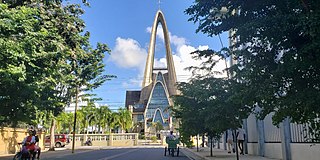
Higüey, or in full Salvaleón de Higüey, is the capital city of the eastern La Altagracia Province, in the Dominican Republic, and the eighth largest city of that country. The Yuma River flows through the urban areas of Higüey.
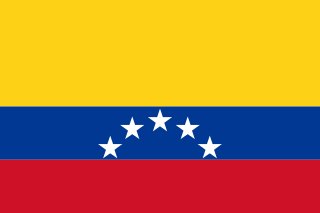
The Republic of Spanish Haiti, also called the Independent State of Spanish Haiti was the independent state that succeeded the Captaincy General of Santo Domingo after independence was declared on November 30, 1821 by José Núñez de Cáceres. The republic lasted only from December 1, 1821 to February 9, 1822 when it was invaded by the Republic of Haiti.

Baní is a capital town of the Peravia Province, Dominican Republic. It is the commercial and manufacturing center in the southern region of Valdesia. The town is located 65 km south of the capital city Santo Domingo.
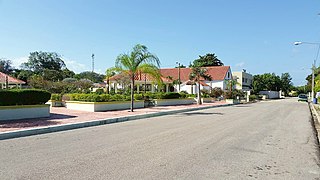
San Francisco de Bánica, or simply Bánica, is a town and municipality in the northwest region of Dominican Republic in the Elías Piña province. It is located on the border with Haiti near the Artibonite river. The name Bánica comes from the Taíno name of the region, Banique.
Miches is a town located in El Seibo province in the northeast coast of the Dominican Republic. The community sits between the northern slopes of the Cordillera Oriental and the southern shore of the Samaná Bay.

The Haitian occupation of Santo Domingo was the annexation and merger of then-independent Republic of Spanish Haiti into the Republic of Haiti, that lasted twenty-two years, from February 9, 1822, to February 27, 1844. The part of Hispaniola under Spanish administration was first ceded to France and merged with the French colony of Saint Domingue as a result of the Peace of Basel in 1795. However, with the outbreak of the Haitian Revolution the French lost the western part of the island, while remaining in control of the eastern part of the island until the Spanish recaptured Santo Domingo in 1809.
Saint-Michel-de-l'Attalaye is a commune in the Marmelade Arrondissement, in the Artibonite department of Haiti. It has 95,216 inhabitants. It is the second largest city geographically after Port-au-Prince, the national capital. Located in the Central Plateau, it is home to several large Christian churches including one which has been there for over 50 years. It is a scenic locale, surrounded by rich farmland, abundant water resources and distant mountain peaks in every direction. There are excellent schools which are privately funded and a current (2011) small residential development outside of the main town area which is near completion which was originally sponsored by the central government. There is a new joint venture nearing completion with a Taiwanese partner that plans to bring bamboo crafts and goods manufacturing skills training to the local people.
Señorita República Dominicana 1962 was held on January 29, 1962, when 26 candidates competed for the national crown. The winner represented the Dominican Republic at the Miss Universe 1962. The first runner up would enter Miss International 1962. Only the 25 provinces and 1 municipality entered. The top ten contestants wore evening gowns and answered questions to get through to the top 5, where they answered more questions.

Manuel de Jesús María Ulpiano Troncoso de la Concha was an intellectual and President of the Dominican Republic from 1940 until 1942. Prior to ascending to the presidency, he was vice-president from 1938 to 1940. His term began upon the death of President Jacinto Peynado. He also served in 1911 during the reign of the Council of Secretaries.
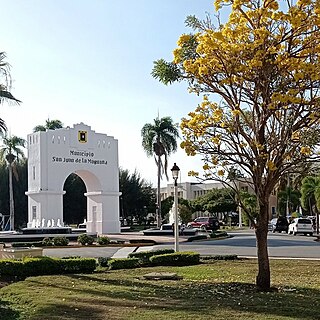
San Juan is a province of the Dominican Republic. Before 1961 it was known as Benefactor. San Juan is the Republic's largest province, bearing a size of 3,569 square kilometers, and it is landlocked.
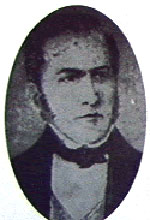
Manuel José Jimenes González was one of the leaders of the Dominican War of Independence. He served as the 2nd President of the Dominican Republic from September 8, 1848, until May 29, 1849. Prior to that he served as the country's Minister of War and Marine Affairs.

The chiefdoms of Hispaniola were the primary political units employed by the Taíno inhabitants of Hispaniola in the early historical era. At the time of European contact in 1492, the island was divided into five chiefdoms or cacicazgos, each headed by a cacique or paramount chief. Below him were lesser caciques presiding over villages or districts and nitaínos, an elite class in Taíno society.
White Dominicans are Dominican people of predominant or full European descent. They are 17.8% of the Dominican Republic's population, according to a 2021 survey by the United Nations Population Fund. The majority of white Dominicans have ancestry from the first European settlers to arrive in Hispaniola in 1492 and are descendants of the Spanish and Portuguese who settled in the island during colonial times, as well as the French who settled in the 17th and 18th centuries. Many whites in the Dominican Republic also descend from Italians, Dutchmen, Germans, Hungarians, Scandinavians, Americans and other nationalities who have migrated between the 19th and 20th centuries. About 9.2% of the Dominican population claims a European immigrant background, according to the 2021 Fondo de Población de las Naciones Unidas survey.

José Gabriel García was a Dominican army officer, historian, politician, journalist and publisher. He is regarded as a cultural pioneer as well as the "Father of Dominican History." He was the author of "Compendium of History of Santo Domingo", published in four volumes in 1867, 1887, 1900 and 1906 respectively, and made numerous contributions in the fields of culture, literature and education.
Don José de Guzmán y Meléndez, 1st Viscount of San Rafael de la Angostura, 1st Baron of San Miguel de la Atalaya, was a Dominican cattle rancher, colonizer, and a peer of the Indies.

Campuzano-Polanco was a prominent family from the Captaincy General of Santo Domingo with origins in Santiago de los Caballeros. During the colonial era of the Hispaniola, their members and descendants went on to occupy high political, military, and ecclesiastical positions, locally and outside the Island, as well as in the metropolis of Spain. Their merits span from the beginning until the end of the colony.
Alberto Ulloa was a painter, sculptor, and poet from Altamira, Dominican Republic. He was a student of the distinguished Latin American painter Jaime Colson, who also mentored Mario Carreño, the Cuban-Chilean master. Ulloa also studied drawing with illustrator and painter Domingo Liz.

Mixed Dominicans, also referred to as mulatto, mestizo or historically quadroon, are Dominicans who are of mixed racial ancestry. Representing 73.9% of the Dominican Republic's population, they are by far the single largest racial grouping of the country.




















